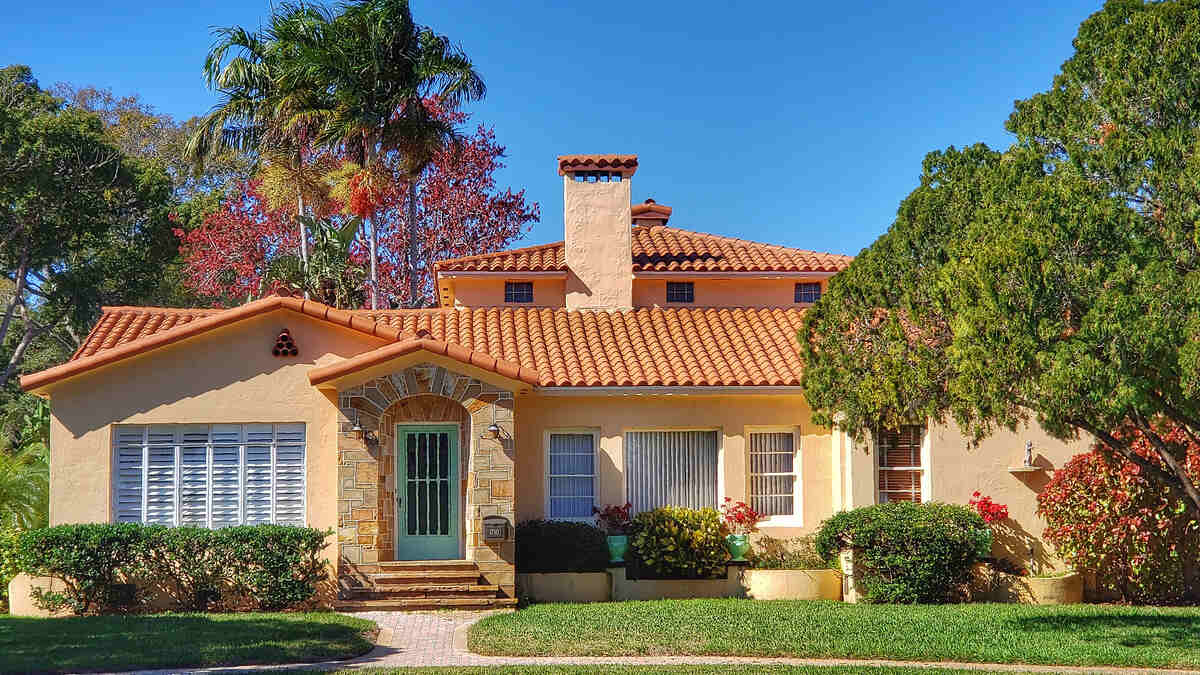
There’s something magical about dew sparkling on your dense, green lawn in the morning. Every Floridian loves waking up to healthy, vibrant, fresh turf. But how do you get it? And how do you keep it healthy in this hot and humid weather? It all starts with the best type of grass for your Florida yard, soil, and local weather.
St. Augustine, Bermuda, Zoysia, Bahia, Centipede, and Seashore Paspalum are all excellent grasses for Florida. But which is the best for you? Choosing the wrong one can become a major nag, so let’s not leave this to chance or gut feeling. Learn more about each grass type from our guide. We have all the valuable insights right here.
- 1. St. Augustinegrass – The Best Grass for Shaded Lawns
- 2. Zoysiagrass – A Good Choice for Heavy Foot Traffic
- 3. Bermudagrass – Excellent for Drought Conditions
- 4. Bahiagrass – The Best Low-Maintenance Grass for Sandy Soils
- 5. Centipedegrass – The Best Type of Grass for Infertile Soils
- 6. Seashore Paspalum – The Best Salt Tolerance
- 7. Buffalograss – Undemanding and Tolerant of High Temperatures
- Best Grass Types for South Florida
- Best Grass Types for Central Florida
- Best Grass Types for North Florida
- FAQ
1. St. Augustinegrass – The Best Grass for Shaded Lawns
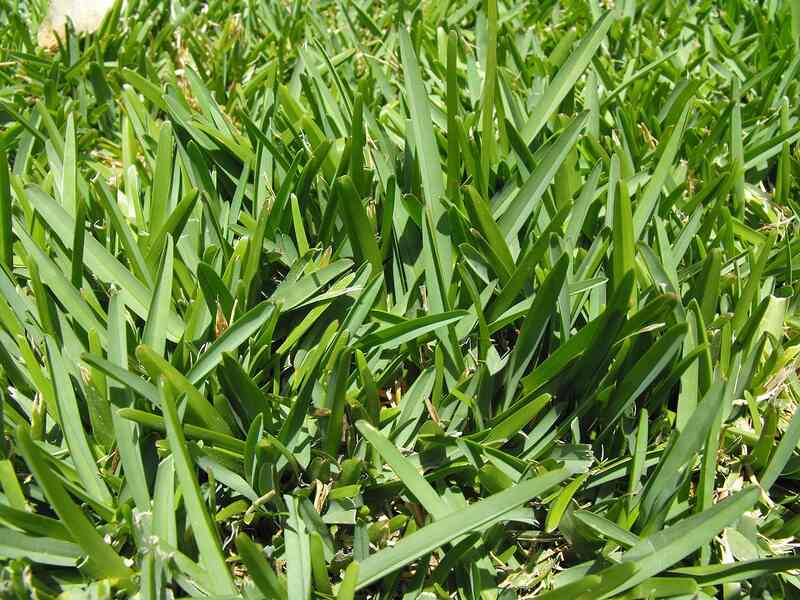
Native to the Mediterranean and the Gulf of Mexico, St. Augustine is a popular choice in Florida. It covers your lawn in thick, dense turf with green to blue-green blades and is well adapted to most soil types and climates across Florida.
Wet and humid weather makes St. Augustinegrass shine. Some salt sprays and a few weeks of drought won’t bother it much. It also tolerates partial shade and is your best bet if you have trees or buildings that shade your yard.
However, this grass has a downside – it grows fast and requires much attention from its owner. To keep St. Augustine healthy and neat, you must mow, fertilize, and dethatch it frequently. But with a little extra effort, the results are totally worth it!
Pro tips for a beautiful St. Augustine lawn in Florida:
- St. Augustine is one of the best grasses to grow in Jacksonville. If you live in North Florida, avoid fertilizing it too early in the spring. You’ll expose the grass to damage by late-season frosts. See our lawn fertilization schedule for Florida to find out the best time to fertilize your lawn depending on your grass type and what region of Florida you live in.
- Apply pre-emergent herbicides starting on February 1 if in South Florida. Wait until February 15 in Central Florida and March 1 in North Florida.
- When you dethatch a St. Augustine lawn, leave a 3-inch space between the blades.
Established by: Sod, sprigs, and plugs. It spreads in your lawn by stolons.
Shade tolerance: Moderate (the most shade-tolerant warm-season grass)
Salt tolerance: Moderate; a good choice for coastal regions
Drought tolerance: Moderate to high
Foot traffic tolerance: Low, unsuitable for lawns used as playgrounds by kids or pets
Maintenance:
- Water with ½–¾ inch per session when the grass shows stress.
- Fertilize two to five times from spring green-up through fall.
Mowing height:
- Maintain standard St. Augustine cultivars (BitterBlue, Floratam, etc.) at 3.5 to 4 inches tall.
- Keep the mowing size at 2 to 2.5 inches for dwarf varieties.
- St. Augustine may not require mowing in North Florida during winter. (Learn more about winter lawn care in Florida in our 10 Winter Lawn Care Tips for Florida.)
Potential for disease and pests: Moderate to high
- St. Augustine is vulnerable to gray leaf spot, large patch, and take-all root rot.
- The southern chinch bug and nematodes are some of the main pests that can severely damage this grass.
Soil type: St. Augustine thrives in moderately fertile and moist soil, with a pH of 6.0 to 7.5. It tolerates various soils but doesn’t adapt well to compacted ground.
St. Augustine cultivars: Floratam, Palmetto, BitterBlue
Grass Plug Options:
– Seed Ranch St Augustine Seville Grass Plugs (2 Trays)
– Seed Ranch St Augustine Floratam Grass Plugs (2 Trays)
2. Zoysiagrass – A Good Choice for Heavy Foot Traffic
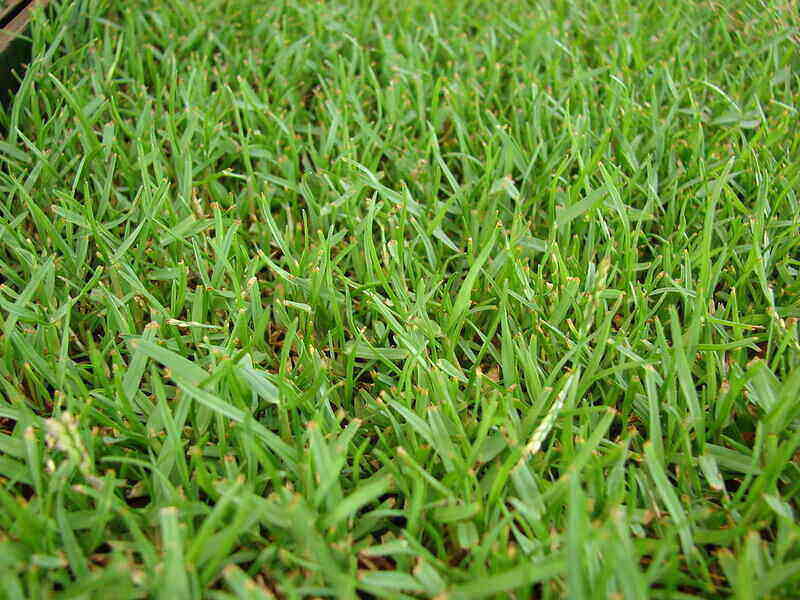
Zoysia has a unique emerald green color and can handle heavy foot traffic without getting messed up. It’s used in home lawns, fancy golf courses, sports fields, and commercial properties.
It takes some patience to get started with Zoysia, though. Since it grows slowly, establishing a new lawn can be more expensive and time-consuming. And during its first year, it’s more prone to getting weeds.
But once Zoysia is settled in your yard, it forms a thick, strong cover that won’t let weeds through. If you’re up for the challenge, Zoysiagrass could be an excellent choice for your lawn!
Pro tips for a beautiful Zoysia lawn in Florida:
- Apply three (North Florida) to six (South Florida) rounds of fertilizer annually.
- Popular among the Pensacola turfgrasses, Zoysia is slow to green up in the spring, especially in North Florida. Ensure fertilization only after the turf has awoken from dormancy to avoid stressing the grass.
Established by: Sod, sprigs, and plugs. It spreads by stolons and rhizomes.
Shade tolerance: It thrives in full sun but also tolerates some light shade.
Salt tolerance: Medium
Drought tolerance: Zoysiagrass can go dormant for three to four weeks during drought and turns green again with the next rainfall.
Foot traffic tolerance: High, but recovers slowly if damaged
Maintenance:
- Zoysia reacts better to “spoon-feeding” (smaller amounts of fertilizer applied more often).
- Irrigate when the grass shows signs of drought stress.
- Mow your Zoysia lawn weekly and keep it 1 to 2 inches tall.
Potential for disease:
- Zoysia’s slow growth exposes it to large patch disease.
- It can become vulnerable to dollar spot disease when the soil is deficient in nitrogen and can be affected by grass rust during mild and humid weather.
Soil type: Zoysia loves well-drained, slightly acidic soil with a pH of 6.0 to 6.5.
Zoysiagrass cultivars: Empire Zoysia, El Toro Zoysia, Zeon Zoysia
Grass Plug and Seed Options:
– Zoysia Plugs (50 Large Grass Plugs)
– Zoysia Plugs (50 Full & Lush Grass Plugs)
– Zoysia Plugs (100 Plugs)
– Zoysia Emerald Grass Seeds (1/8 lb. of seeds)
– Zenith Zenith Grass Seeds (1/8 lb. of seeds)
3. Bermudagrass – Excellent for Drought Conditions
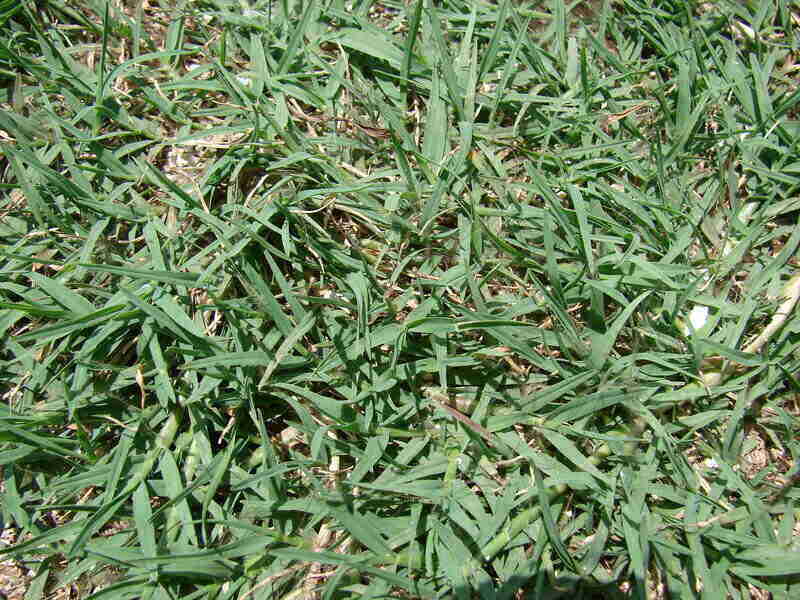
Bermudagrass is an excellent choice for lawns in Florida. It grows quickly, thick and dense, and withstands heavy traffic, salty conditions, and drought. Plus, it helps conserve water, which is crucial in Florida. Learn more advice on how to water your Florida lawn efficiently in our watering guide, whether your lawn is Bermudagrass or a less drought-tolerant grass type.
Bermuda’s dark green blades and neat look make it a popular choice for golf courses and athletic fields. It’s a fast grower and requires frequent mowing, fertilizing, and dethatching. Keeping a Bermuda lawn looking great takes time and effort, but it is definitely worthwhile!
Pro tips for a beautiful Bermuda lawn in Florida:
- Apply fertilizer in 2 to 6 sessions from April to September.
- Florida soils have an average pH of 6.1. Bermuda needs a pH of 6.0 to 7.0. Test the soil periodically to ensure a suitable pH all year round.
Established by: Sod, sprigs, plugs, and seeds. It spreads by stolons and rhizomes.
Shade tolerance: Low. Bermuda needs full sun exposure, and in partial shade won’t grow as thick and beautiful.
Salt tolerance: Medium
Drought tolerance: Medium to high. It can recover even after ten weeks of drought.
Foot traffic tolerance: Medium to high. Consider it for a lawn where pets and kids play often.
Maintenance:
- It’s a fast grower and needs proper fertilization in spring and fall.
- Water when the grass shows signs of drought.
Mowing height: Mow Bermuda 1.5 to 2.5 inches tall once or twice a week.
Potential for disease and pests:
- Dollar spot disease, Helminthosporium, and large spot disease can damage Bermuda lawns.
- Nematodes are the most severe pest for Bermuda lawns. They cause thinning and yellowing during dry, hot weeks.
- As for Florida lawn pests, mole crickets are the primary concern. Sod webworms, grass loppers, armyworms, and cutworms are also a potential problem.
Soil: Bermuda grows well in most soil types, with pH levels between 6.0 and 7.0.
Bermudagrass cultivars: Celebration, Tifway 419, Latitude 36
Grass Seed Options:
– Pennington Bermudagrass Bare Spot (5 lb. bag)
– Pennington Smart Seed Bermudagrass Mix (8.75-lb. bag)
– Scotts Turf Builder Bermudagrass (10-lb. bag)
– Hancock Seed Co. Bermudagrass (50-lb. bag)
4. Bahiagrass – The Best Low-Maintenance Grass for Sandy Soils
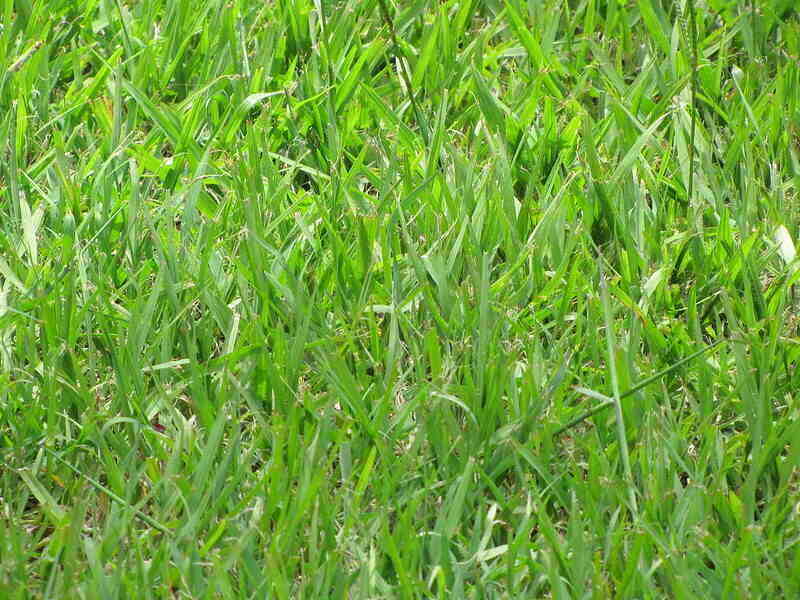
Photo Credit: Forest and Kim Starr / Flickr / CC BY 2.0
Bahiagrass is a beautiful, low-maintenance, green grass for lawns with infertile, sandy soils. It can adapt to different soil conditions and doesn’t need much water or fertilizer.
While Bahiagrass might not look as perfect as other grasses, it’s an excellent choice if you’re on a budget. Another benefit of Bahiagrass is that it doesn’t form thatch as quickly as Bermuda or St. Augustine. You won’t have to spend as much time and money maintaining it.
Pro tips for a beautiful Bahia lawn in Florida:
- Bahia needs well-drained soil. Till the lawn 6 to 8 inches deep before planting if there is a high degree of compaction.
- Avoid plugging and sprigging. Bahia is a slow-growing grass and needs a long time to cover the yard uniformly. It’s best established by sod to keep weeds under control. Seeds are the second best option.
- Don’t overwater bahiagrass. It promotes weeds and stresses the turf. To keep Bahia green and healthy, water only when the grass starts to wilt, fold, and turn a blue-gray shade.
Established by: Sod and seeds. It spreads by stolons.
Shade tolerance: Low, but more shade-tolerant than Bermuda.
Salt tolerance: Low. Less suitable for the coastal regions of Florida.
Drought tolerance: Moderate
Foot traffic tolerance: Low. It’s more fragile than other grasses and doesn’t tolerate heavy traffic.
Maintenance:
- Low fertility requirements. If leaf blades go yellow, it might be an iron deficiency. Apply iron sources but avoid granular products. They are often ineffective in Florida soils.
- Mow bahiagrass 3 to 4 inches tall every 7–14 days during active growth. It has tough leaves and seed-head stems. You must sharpen the mower blade regularly for a clean cut.
Potential for disease and pests:
- Bahia resists various fungal diseases, but dollar spot disease can become active in poor soil. Treat it by applying small amounts of nitrogen.
- Mole crickets are the most common insects to damage Bahia lawns in Florida.
- This lawn grass has an extensive, deep root system. Nematodes rarely damage it enough to get noticed. But it can happen. Test the lawn if the grass looks suspiciously thin and wilted.
Soil: Bahia thrives in acidic soils with a pH of 5.5 to 6.5. Alkaline soils expose Bahia to iron deficiency. You’ll find them in Miami, Fort Meyers, Naples, and Pensacola.
Bahiagrass cultivars to consider for Florida: Pensacola Bahiagrass, Argentine Bahiagrass, Paraguay 22 Bahiagrass
Grass Seed Options
Pensacola Bahiagrass:
– Scotts Turf Builder Pensacola Bahiagrass (5 lb. bag)
– Hancock Seed Co. Pensacola Bahiagrass Seed (5 lb. bag)
– SeedRanch Pensacola Bahiagrass Seed (10 lb. bag)
Argentine Bahiagrass:
– Scotts Turf Builder Argentine Bahiagrass (10 lb. bag)
– Hancock Seed Co. Argentine Bahiagrass Seed Mix (25 lb. bag)
5. Centipedegrass – The Best Type of Grass for Infertile Soils
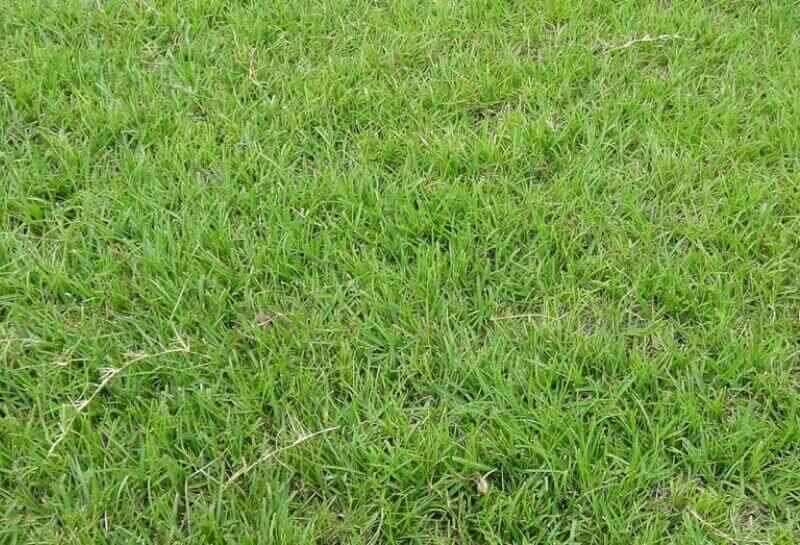
Photo credit: Michael Rivera / Wikimedia Commons / CC BY-SA 4.0
Centipedegrass is the right grass for the soil and weather conditions of Northern and Central Florida. It grows light green, medium-textured blades and thrives in infertile soils. You’ll love its low-maintenance, undemanding style.
Centipede stands beautiful and tall (ideally, 1 to 2 inches tall) with less mowing and fertilization than other Florida grasses. Keeping a centipedegrass lawn healthy doesn’t take too much work. It can also tolerate some shade from buildings and trees and is drought-resistant.
Pro tips for a beautiful centipedegrass lawn in Florida:
- Avoid installing plugs or sprigs. You’ll get a lawn with open areas of soil where weeds invade.
- Centipede grass is naturally a light green. Do not apply nitrogen to darken the blades. Overfertilization leads to a heavy thatch layer, making the grass vulnerable to disease.
Established by: Sod and seeds. Plugs and sprigs are available but not recommended. Centipede spreads by stolons.
Shade tolerance: Moderate. Choose it for a lawn without many shaded patches.
Salt tolerance: Low; not a good choice for coastal regions
Drought tolerance: Needs 1 to 1.25 inches of water weekly and can survive several weeks without water.
Foot traffic tolerance: Low. Consider it for more isolated areas of your yard.
Maintenance:
- Fertilize in 1 to 3 applications from spring green-up through fall.
- Irrigate on an as-needed basis.
- Mow every 7 to 14 days and maintain a mowing height of 1 to 2 inches to encourage root growth and healthy grass.
Potential for disease and pests:
- Lawns are often damaged by centipede decline. It is a complex disease triggered by high nitrogen content in soil with a pH over 6.5.
- Centipede is susceptible to ring nematodes and ground pearls, a type of scale insect.
Soil: This type of grass does very well in sandy, infertile, acidic soils (pH of 4.5 to 6.5), with good drainage. Avoid planting in South Florida coastal areas where soil tends to be alkaline.
Centipede cultivars to consider for Florida: Tennessee Hardy, Common Centipede, Oaklawn
Grass Seed Options:
– Gulf Kist Coated Centipedegrass Seeds (1 lb.)
– Scotts EZ Seed Patch and Repair Centipedegrass (3.75 lbs.)
– TifBlair Centipedegrass (5-lb. bag)
– Pennington Centipedegrass and Mulch (5-lb. bag)
6. Seashore Paspalum – The Best Salt Tolerance
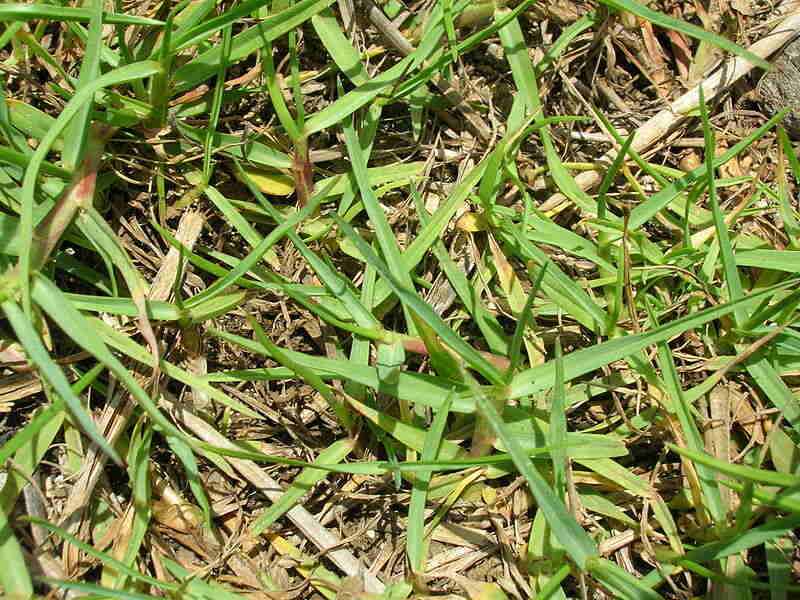
Photo Credit: Forest & Kim Starr / Wikimedia Commons / CC BY 3.0
With its light to medium-green blades, this native Florida grass is not fancy, but it sure can handle salt!
Seashore paspalum has the highest salt tolerance among warm-season grasses. It’s a popular choice for areas near the coast, where saltwater intrusion is most problematic. Examples are Miami, Tampa, Jacksonville, Naples, and Everglades City.
Keep in mind this grass is not low-maintenance. It has an aggressive growth habit and becomes thatchy if over-watered and over-fertilized. You need to mow often and dethatch periodically to keep it healthy.
Pro tips for a beautiful seashore paspalum lawn in Florida:
- Seashore Paspalum is sensitive to many commercial herbicides. It’s better to hire a professional to handle weed control.
- Keep it 1 to 2 inches in height. Taller seashore paspalum loses density and fosters thatch.
Established by: Sod and plugs. It spreads by rhizomes and stolons.
Shade Tolerance: Low to Moderate
Salt tolerance: High
Drought Tolerance: Moderate
Foot Traffic Tolerance: Moderate. It can tolerate some wear and recovers fast from moderate traffic during the growing season.
Maintenance:
- Use fertilizer moderately. Apply organic or slow-release fertilizer in spring and fall at a rate of 2-3 lbs./1000 sq. ft. of total nitrogen per growing season.
- Irrigate with ½ to ¾ inch of water when the grass shows signs of drought.
Mowing height: Maintain a height of 1 to 2 inches. Mow once or twice weekly during the growing season to keep seed heads from appearing.
Potential for disease and pests:
- Large patch and dollar spot are common diseases to watch for.
- The main insect problems you can expect are fall armyworms and sod webworms. Mole crickets can also do some damage, but less than on Bermudagrass.
Soil: It tolerates various types of soils, including wet, saline soil. It deals well with a wide pH range, from 3.6 to 10.2.
Seashore paspalum cultivars to consider for Florida: SeaIsle 1, Platinum TE, Salam
Grass Seed and Sod Options:
– Seed Ranch SeaShore Paspalum Coated Grass Seed – 1 lb.
– Seed World SeaShore Paspalum Grass Seeds (various amounts)
– Other places to purchase seashore paspalum sod
7. Buffalograss – Undemanding and Tolerant of High Temperatures
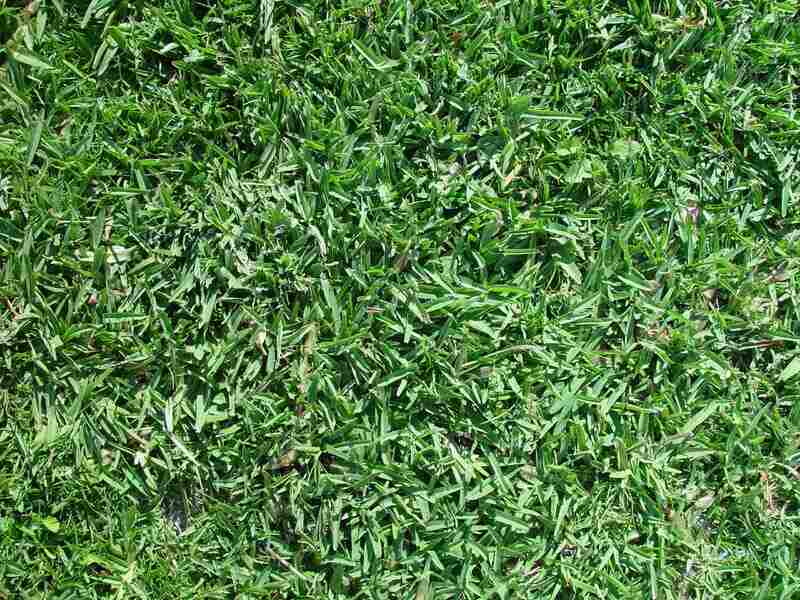
Photo Credit: Pixnio
Buffalograss is a North American native grass that can handle heat, drought, and low temperatures. It’s a popular choice for low-maintenance lawns in Florida because it doesn’t need a lot of water, fertilizer, or mowing. But be careful. It can become weedy due to its “open growth” habit.
Plant buffalograss in full sun and avoid shaded areas to keep it looking its best. Its green color with a blue or bluish-gray tint is beautiful, and the grass has good resistance to diseases and insects. However, in high humidity and poorly drained soil, this can change.
Pro tips for a beautiful buffalograss lawn in Florida:
- Buffalograss needs rich, well-drained sandy loam soil. Since Florida has primarily sandy soils, add some humus or compost to your lawn before seeding. Consult a lawn care professional to get the details right.
- Improve lawn drainage if you plant buffalograss. It has a low tolerance for water pooling and prolonged moisture.
Established by: Seeds. It spreads by stolons.
Shade tolerance: Low. Install it on areas with full sun exposure.
Salt tolerance: Low to moderate
Drought tolerance: High; tolerates extended periods of drought and extreme heat
Foot traffic tolerance: Low
Maintenance:
- It needs less fertilizer than other grasses (1 or 2 pounds of nitrogen per 1,000 square feet yearly, in two applications).
- During summer, only irrigate during drought periods to support growth and prevent the grass from going dormant. With Florida’s rainy summers, you might not need to water it for weeks.
Mowing height:
- High-quality turf requires weekly mowing at 2 to 3 inches tall.
- For a low-maintenance lawn, mow at 3 to 4 inches every three to four weeks. You can also do one single mow at 3 to 4 inches in the spring to remove old growth.
Potential for disease and pests:
- Overwatering and too much nitrogen can trigger brown patch.
- White grubs and chinch bugs can severely damage buffalograss lawns.
Soil: It thrives in rich and well-drained sandy loam soil and tolerates clay with good drainage.
Buffalo grass cultivars: Plains, Bison, Cody
Grass Seed Options:
– Everwilde Farms Buffalograss Seeds (1 lb. of seeds)
– Scotts Pursue Buffalograss with Natural Seed (1 lb. of seeds)
– Outsidepride Perennial Buffalo Grass Seed (2 lb. of seeds)
Best Grass Types for South Florida
The top warm-season grasses in Tampa, Miami, St. Petersburg, and all of sunny South Florida are St. Augustinegrass, Bermudagrass, and Zoysiagrass. These grasses are well adapted to the hot and humid climate in the region and can tolerate salt spray and periodic flooding.
Bahia is also popular, but less so in the coastal areas since its salt tolerance is low.
Best Grass Types for Central Florida
The most common warm-season grasses in Central Florida are St. Augustinegrass, a high-maintenance beauty, and Bahiagrass, the low-maintenance and more resilient alternative.
Zoysia is also popular, often seen on golf courses but less common in Orlando and its surroundings than in South Florida. Centipede is the right grass for Central Florida homeowners searching for a less demanding turfgrass.
Best Grass Types for North Florida
The most commonly used turfgrasses in North Florida are St. Augustine, Bermuda, and Zoysia.
Homeowners in Pensacola, Tallahassee, Jacksonville, and the surrounding areas also grow Bahia, the most drought-tolerant and least expensive lawn grass for North Florida.
Centipede is another common grass in this region, well adapted to North Florida and the Panhandle soils and climate.
FAQ
The most common turfgrass in Florida is St. Augustinegrass (Stenotaphrum secundatum), followed by Bermudagrass (Cynodon spp.) and Zoysiagrass (Zoysia spp.)
There is no one-size-fits-all answer to this question, as it depends on specific location, soil type, and climate conditions. However, some of the easiest turfgrasses in Florida include Bahiagrass, centipedegrass, and buffalograss.
The best grass for heavy-traffic areas in Florida is typically Bermudagrass. Other grasses that can handle moderate to heavy traffic are Zoysia and centipede.
Centipede, St. Augustine, and Zoysia are the best turfgrasses for Florida’s sandy soils.
A salt-tolerant grass type, such as seashore paspalum, would be best at surviving hurricane weather. See our other article for more hurricane-resistant landscaping ideas for Florida.
Install the Perfect Florida Lawn Today!
The best grass for your Florida lawn is one that enjoys the yard’s soil and local weather and perfectly fits your lawn care style. Should it be the neat but pretentious Bermuda? The easy-going but not-so-fancy Bahia? Or the popular and demanding St. Augustine?
It’s a long-term commitment you’re starting here, so, if in doubt, always ask a pro. Contact a lawn care service near you to find the perfect grass for your Florida lawn today! Find a lawn care company faster on our local pages if you live in or near Miami, Tampa, Orlando, Jacksonville, or St. Petersburg.
LawnStarter participates in the Amazon Services LLC Associates Program, an affiliate advertising program. LawnStarter earns revenue from products promoted in this article.
Main Image Credit: Calmuziclover / Flickr / CC BY 2.0